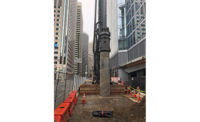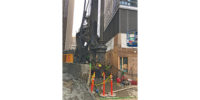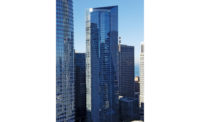After more than six months of scrutiny, San Francisco’s Department of Building Inspection has issued a revised building permit for the revamped perimeter pile upgrade of the settling 645-ft-tall Millennium Tower, thanks to a determination from the planning department that the revised scheme would not have any negative environmental impacts. The upgrade now consists of 18 piles to bedrock, already installed, rather than 52.
"In consultation with the engineering design review team, the San Francisco Department of Building Inspection has approved the revised permit applications for the 301 Mission foundation retrofit," says DBI in a statement.
Two weeks ago, Shimmick Construction completed a wall to shore Mission Street, which runs alongside the building, according to Doug Elmets, a spokesman for the Millennium Tower homeowners association. This will enable crews to begin jet grouting and excavation of a 25-ft-deep trench adjacent to the building on the Mission side. Shimmick will then tie the Mission piles into the building's expanded mat.
Shimmick is expected to complete the Mission work in December. After that, crews will perform the same operations and transfer load to the new piles along Fremont Street, which crosses Mission.
Problems With Original Pile Work
The revised scheme is a consequence of problems with the original pile work. The engineer for the repair, Simpson Gumpertz Heger, halted work in August of last year, after the voluntary fix, designed to stem more than 17-in. of settlement primarily near the northwest corner, had instead accelerated it, causing a 1-in. increase. SGH, Shimmick and a team of experts then revamped the pile installation work itself to stem the problem.
Following that, SGH re-engineered the scheme to reduce the number of piles to 18. In June, the city's review team scrutinizing the upgrade OK’d the 18-pile plan, saying the reduced scope would accomplish the original project objectives of arresting the horizontal and vertical movement, as well as reducing a portion of the building’s current tilt over time.






Post a comment to this article
Report Abusive Comment